阿莫西林原料药质量标准USP-36版
阿莫西林工艺开发报告((Amoxicillin))
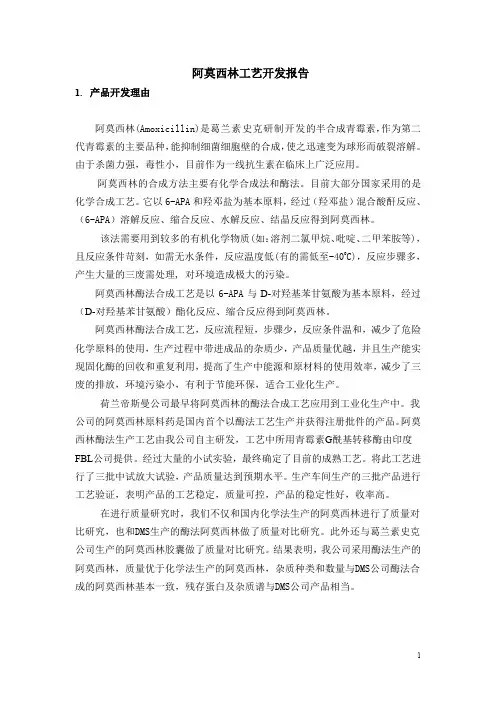
阿莫西林工艺开发报告1.产品开发理由阿莫西林(Amoxicillin)是葛兰素史克研制开发的半合成青霉素,作为第二代青霉素的主要品种,能抑制细菌细胞壁的合成,使之迅速变为球形而破裂溶解。
由于杀菌力强,毒性小,目前作为一线抗生素在临床上广泛应用。
阿莫西林的合成方法主要有化学合成法和酶法。
目前大部分国家采用的是化学合成工艺。
它以6-APA和羟邓盐为基本原料,经过(羟邓盐)混合酸酐反应、(6-APA)溶解反应、缩合反应、水解反应、结晶反应得到阿莫西林。
该法需要用到较多的有机化学物质(如:溶剂二氯甲烷、吡啶、二甲苯胺等),且反应条件苛刻,如需无水条件,反应温度低(有的需低至-400C),反应步骤多,产生大量的三废需处理, 对环境造成极大的污染。
阿莫西林酶法合成工艺是以6-APA与D-对羟基苯甘氨酸为基本原料,经过(D-对羟基苯甘氨酸)酯化反应、缩合反应得到阿莫西林。
阿莫西林酶法合成工艺,反应流程短,步骤少,反应条件温和,减少了危险化学原料的使用,生产过程中带进成品的杂质少,产品质量优越,并且生产能实现固化酶的回收和重复利用,提高了生产中能源和原材料的使用效率,减少了三废的排放,环境污染小,有利于节能环保,适合工业化生产。
荷兰帝斯曼公司最早将阿莫西林的酶法合成工艺应用到工业化生产中。
我公司的阿莫西林原料药是国内首个以酶法工艺生产并获得注册批件的产品。
阿莫西林酶法生产工艺由我公司自主研发,工艺中所用青霉素G酰基转移酶由印度FBL公司提供。
经过大量的小试实验,最终确定了目前的成熟工艺。
将此工艺进行了三批中试放大试验,产品质量达到预期水平。
生产车间生产的三批产品进行工艺验证,表明产品的工艺稳定,质量可控,产品的稳定性好,收率高。
在进行质量研究时,我们不仅和国内化学法生产的阿莫西林进行了质量对比研究,也和DMS生产的酶法阿莫西林做了质量对比研究。
此外还与葛兰素史克公司生产的阿莫西林胶囊做了质量对比研究。
结果表明,我公司采用酶法生产的阿莫西林,质量优于化学法生产的阿莫西林,杂质种类和数量与DMS公司酶法合成的阿莫西林基本一致,残存蛋白及杂质谱与DMS公司产品相当。
阿莫西林可溶性粉(半成品)内控质量标准
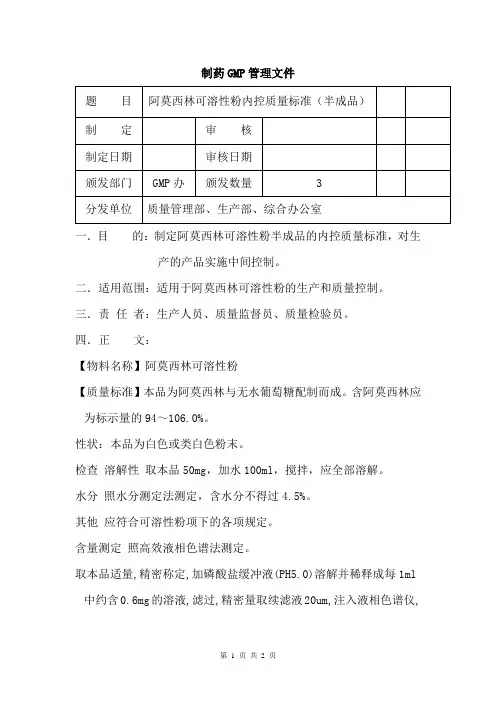
制药GMP管理文件
一.目的:制定阿莫西林可溶性粉半成品的内控质量标准,对生产的产品实施中间控制。
二.适用范围:适用于阿莫西林可溶性粉的生产和质量控制。
三.责任者:生产人员、质量监督员、质量检验员。
四.正文:
【物料名称】阿莫西林可溶性粉
【质量标准】本品为阿莫西林与无水葡萄糖配制而成。
含阿莫西林应为标示量的94~106.0%。
性状:本品为白色或类白色粉末。
检查溶解性取本品50mg,加水100ml,搅拌,应全部溶解。
水分照水分测定法测定,含水分不得过4.5%。
其他应符合可溶性粉项下的各项规定。
含量测定照高效液相色谱法测定。
取本品适量,精密称定,加磷酸盐缓冲液(PH5.0)溶解并稀释成每1ml 中约含0.6mg的溶液,滤过,精密量取续滤液20um,注入液相色谱仪,
记录色谱图;另取阿莫西林对照品适量,同法测定,按外标法以峰面积计算出供试品中阿莫西林的含量。
【取样办法】见取样管理制度。
【规格】 100g:10g。
USP 35阿司匹林原料药质量标准
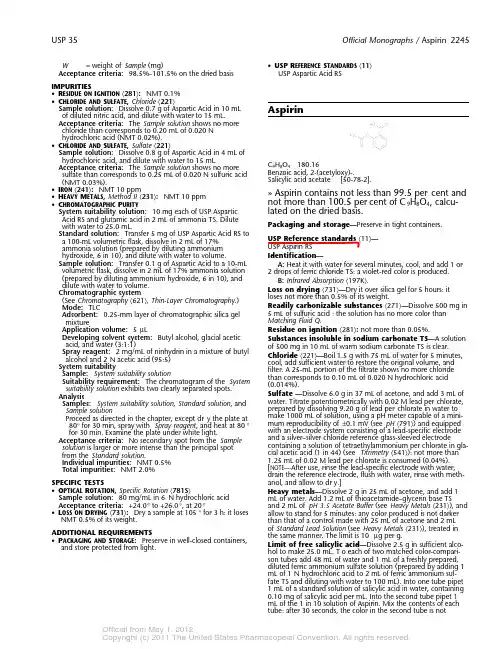
USP 35Official Monographs / Aspirin 2245W = weight of Sample (mg)•USP R EFERENCE S TANDARDS 〈11〉Acceptance criteria: 98.5%–101.5% on the dried basis USP Aspartic Acid RSIMPURITIES•R ESIDUE ON I GNITION 〈281〉: NMT 0.1%•C HLORIDE AND S ULFATE , Chloride 〈221〉Sample solution: Dissolve 0.7 g of Aspartic Acid in 10 mL Aspirinof diluted nitric acid, and dilute with water to 15 mL.Acceptance criteria: The Sample solution shows no more chloride than corresponds to 0.20 mL of 0.020 N hydrochloric acid (NMT 0.02%).•C HLORIDE AND S ULFATE , Sulfate 〈221〉Sample solution: Dissolve 0.8 g of Aspartic Acid in 4 mL of hydrochloric acid, and dilute with water to 15 mL.C 9H 8O 4180.16Acceptance criteria: The Sample solution shows no more Benzoic acid, 2-(acetyloxy)-.sulfate than corresponds to 0.25 mL of 0.020 N sulfuric acid Salicylic acid acetate [50-78-2].(NMT 0.03%).•I RON 〈241〉: NMT 10 ppm» Aspirin contains not less than 99.5 per cent and •H EAVY M ETALS , Method II 〈231〉: NMT 10 ppm not more than 100.5 per cent of C 9H 8O 4, calcu-•C HROMATOGRAPHIC P URITYSystem suitability solution: 10 mg each of USP Aspartic lated on the dried basis.Acid RS and glutamic acid in 2 mL of ammonia TS. Dilute Packaging and storage—Preserve in tight containers.with water to 25.0 mL.Standard solution: Transfer 5 mg of USP Aspartic Acid RS to USP Reference standards 〈11〉—a 100-mL volumetric flask, dissolve in 2 mL of 17%USP Aspirin RS ammonia solution (prepared by diluting ammonium Identification—hydroxide, 6 in 10), and dilute with water to volume.Sample solution: Transfer 0.1 g of Aspartic Acid to a 10-mL A: Heat it with water for several minutes, cool, and add 1 or volumetric flask, dissolve in 2 mL of 17% ammonia solution 2 drops of ferric chloride TS: a violet-red color is produced.(prepared by diluting ammonium hydroxide, 6 in 10), and B: Infrared Absorption 〈197K 〉.dilute with water to volume.Loss on drying 〈731〉—Dry it over silica gel for 5 hours: it Chromatographic systemloses not more than 0.5% of its weight.(See Chromatography 〈621〉, Thin-Layer Chromatography .)Readily carbonizable substances 〈271〉—Dissolve 500 mg in Mode: TLC5 mL of sulfuric acid : the solution has no more color than Adsorbent: 0.25-mm layer of chromatographic silica gel Matching Fluid Q.mixtureApplication volume: 5 µLResidue on ignition 〈281〉: not more than 0.05%.Developing solvent system: Butyl alcohol, glacial acetic Substances insoluble in sodium carbonate TS—A solution acid, and water (3:1:1)of 500 mg in 10 mL of warm sodium carbonate TS is clear.Spray reagent: 2 mg/mL of ninhydrin in a mixture of butyl Chloride 〈221〉—Boil 1.5 g with 75 mL of water for 5 minutes,alcohol and 2N acetic acid (95:5)cool, add sufficient water to restore the original volume, and System suitabilityfilter. A 25-mL portion of the filtrate shows no more chloride Sample: System suitability solutionthan corresponds to 0.10 mL of 0.020 N hydrochloric acid Suitability requirement: The chromatogram of the System (0.014%).suitability solution exhibits two clearly separated spots.Sulfate —Dissolve 6.0 g in 37 mL of acetone, and add 3 mL of Analysiswater. Titrate potentiometrically with 0.02 M lead per chlorate,Samples: System suitability solution , Standard solution , and prepared by dissolving 9.20 g of lead per chlorate in water to Sample solutionmake 1000 mL of solution, using a pH meter capable of a mini-Proceed as directed in the chapter, except dr y the plate at mum reproducibility of ±0.1 mV (see pH 〈791〉) and equipped 80° for 30 min, spray with Spray reagent , and heat at 80°with an electrode system consisting of a lead-specific electrode for 30 min. Examine the plate under white light.and a silver–silver chloride reference glass-sleeved electrodeAcceptance criteria: No secondar y spot from the Sample containing a solution of tetraethylammonium per chlorate in gla-solution is larger or more intense than the principal spot cial acetic acid (1 in 44) (see Titrimetry 〈541〉): not more than from the Standard solution .1.25 mL of 0.02 M lead per chlorate is consumed (0.04%).Individual impurities: NMT 0.5%[NOTE —After use, rinse the lead-specific electrode with water,Total impurities: NMT2.0%drain the reference electrode, flush with water, rinse with meth-anol, and allow to dr y.]SPECIFIC TESTS•O PTICAL R OTATION , Specific Rotation 〈781S 〉Heavy metals—Dissolve 2g in 25 mL of acetone, and add 1Sample solution: 80 mg/mL in 6N hydrochloric acid mL of water. Add 1.2 mL of thioacetamide–glycerin base TSAcceptance criteria: +24.0° to +26.0°, at 20°and 2 mL of pH 3.5 Acetate Buffer (see Heavy Metals 〈231〉), and •L OSS ON D RYING 〈731〉: Dry a sample at 105° for 3 h: it loses allow to stand for 5 minutes: any color produced is not darker NMT 0.5% of its weight.than that of a control made with 25 mL of acetone and 2 mL of Standard Lead Solution (see Heavy Metals 〈231〉), treated in ADDITIONAL REQUIREMENTSthe same manner. The limit is 10 µg per g.•P ACKAGING AND S TORAGE : Preserve in well-closed containers,Limit of free salicylic acid—Dissolve 2.5 g in sufficient alco-and store protected from light.hol to make 25.0 mL. T o each of two matched color-compari-son tubes add 48 mL of water and 1 mL of a freshly prepared,diluted ferric ammonium sulfate solution (prepared by adding 1mL of 1N hydrochloric acid to 2 mL of ferric ammonium sul-fate TS and diluting with water to 100 mL). Into one tube pipet 1 mL of a standard solution of salicylic acid in water, containing 0.10 mg of salicylic acid per mL. Into the second tube pipet 1mL of the 1 in 10 solution of Aspirin. Mix the contents of each tube: after 30 seconds, the color in the second tube is not2246Aspirin / Official MonographsUSP 35more intense than that in the tube containing the salicylic acid Standard preparation—Prepare a solution in Diluting solution (0.1%).having known concentrations of about 0.4 mg of USP Aspirin RS and 0.01 mg of USP Salicylic Acid RS per mL.Assay—Place about 1.5 g of Aspirin, accurately weighed, in a flask, add 50.0 mL of 0.5 N sodium hydroxide VS, and boil the Assay preparation—Weigh and finely powder not fewer than mixture gently for 10 minutes. Add phenolphthalein TS, and 10 Boluses. Transfer an accurately weighed portion of the pow-titrate the excess sodium hydroxide with 0.5 N sulfuric acid VS.der, equivalent to about 400 mg of aspirin, to a 100-mL volu-Perform a blank determination (see Residual Titrations under Ti-metric flask, dilute with Diluting solution to volume, and stir by trimetry 〈541〉). Each mL of 0.5 N sodium hydroxide is equiva-mechanical means for about 15 minutes. Pass a portion of this lent to 45.04 mg of C 9H 8O 4.solution through a filter having a 0.5-µm or finer porosity, and use the filtrate as the Assay preparation .Chromatographic system (see Chromatography 〈621〉)—The liquid chromatograph is equipped with a 254-nm detector and a 4.6-mm × 25-cm column that contains 5-µm packing L1. The Aspirin Bolusesflow rate is about 1 mL per minute. Chromatograph the Stan-dard preparation , and record the peak responses as directed for » Aspirin Boluses contain not less than 90.0 per-Procedure: the relative retention times are about 0.6 for salicylic acid and 1.0 for aspirin, and the relative standard deviation of cent and not more than 110.0 per cent of the the aspirin peak response for replicate injections is not more labeled amount of aspirin (C 9H 8O 4).than 2.0%.Packaging and storage—Preserve in tight containers.Procedure—Separately inject equal volumes (about 20 µL) of the Standard preparation and the Assay preparation into the Labeling—Label Boluses to indicate that they are for veterinar y chromatograph, record the chromatograms, and measure the use only.responses for the major peaks. Calculate the quantity, in mg, of USP Reference standards 〈11〉—aspirin (C 9H 8O 4) in the portion of Boluses taken by the formula:USP Aspirin RS1000C (r U /r S )USP Salicylic Acid RS Identification—in which C is the concentration, in mg per mL, of USP Aspirin A: Crush 1 Bolus, boil a portion of the powder, equivalent to RS in the Standard preparation; and r U and r S are the aspirin about 300 mg of aspirin, with 50 mL of water, cool, and add a peak responses obtained from the Assay preparation and the drop of ferric chloride TS: a violet-red color is produced.Standard preparation, respectively.B: The retention time of the aspirin peak in the chromato-gram of the Assay preparation corresponds to that in the chro-matogram of the Standard preparation, as obtained in the Assay .Dissolution 〈711〉—Aspirin CapsulesMedium: 0.5 M phosphate buffer, pH 7.4; 900 mL.Apparatus 2: 75 rpm.» Aspirin Capsules contain not less than 93.0 per-Time: 45 minutes.cent and not more than 107.0 per cent of the Diluting solution—Prepare a mixture of acetonitrile and for-labeled amount of aspirin (C 9H 8O 4).mic acid (99:1).NOTE —Capsules that are enteric-coated or the Procedure—Determine the amount of aspirin (C 9H 8O 4) dis-contents of which are enteric-coated meet the solved by employing UV absorption at the wavelength of the isosbestic point of aspirin and salicylic acid at 265±2 nm on requirements for Aspirin Delayed-Release Capsules .filtered portions of the solution under test, suitably diluted with Packaging and storage—Preserve in tight containers.Diluting solution, if necessar y, in comparison with a Standard solution having a known concentration of USP Aspirin RS in the USP Reference standards 〈11〉—same Medium . [NOTE —Prepare the Standard solution at the time USP Aspirin RS of use.]Identification—Tolerances—Not less than 80% (Q) of the labeled amount of C 9H 8O 4 is dissolved in 45 minutes.A: Heat about 100 mg of the Capsule contents with 10 mL of water for several minutes, cool, and add 1 drop of ferric Uniformity of dosage units 〈905〉: meet the requirements.chloride TS: a violet-red color is produced.Limit of salicylic acid—Using the chromatograms of the B: Shake a quantity of the contents of Capsules, equivalent Standard preparation and the Assay preparation, obtained as di-to about 500 mg of aspirin, with 10 mL of alcohol for several rected in the Assay, calculate the per centage of salicylic acid minutes. Centrifuge the mixture. Pour off the clear supernatant (C 7H 6O 3) in the portion of Boluses taken by the formula:and evaporate it to dr yness. Dry the residue in vacuum at 60°for 1 hour: the residue responds to Identification test B under 100,000(C /W A )(r U /r S )Aspirin .in which C is the concentration, in mg per mL, of USP Salicylic Dissolution 〈711〉—Acid RS in the Standard preparation; W A is the quantity, in mg,Medium: 0.05 M acetate buffer, prepared by mixing 2.99of aspirin (C 9H 8O 4) in the portion of Boluses taken, as deter-g of sodium acetate trihydrate and 1.66 mL of glacial acetic mined in the Assay; and r U and r S are the salicylic acid peakacid with water to obtain 1000 mL of solution having a pH of responses obtained from the Assay preparation and the Standard 4.50 ± 0.05; 500 mL.preparation, respectively: not more than 0.3% is found.Apparatus 1: 100 rpm.Assay—Time: 30 minutes.Mobile phase—Dissolve 2g of sodium 1-heptanesulfonate in Procedure—Determine the amount of C 9H 8O 4 dissolved from a mixture of 850 mL of water and 150 mL of acetonitrile, and UV absorbances at the wavelength of the isosbestic point of adjust with glacial acetic acid to a pH of 3.4. Make any neces-aspirin and salicylic acid at 265±2 nm of filtered portions of sary adjustments (see System Suitability under Chromatography the solution under test, suitably diluted with Medium, if neces-〈621〉).sary, in comparison with a Standard solution having a known Diluting solution—Prepare a mixture of acetonitrile and for-concentration of USP Aspirin RS in the same Medium. [NOTE —mic acid (99:1).。
阿莫西林原料药质量标准USP-36版
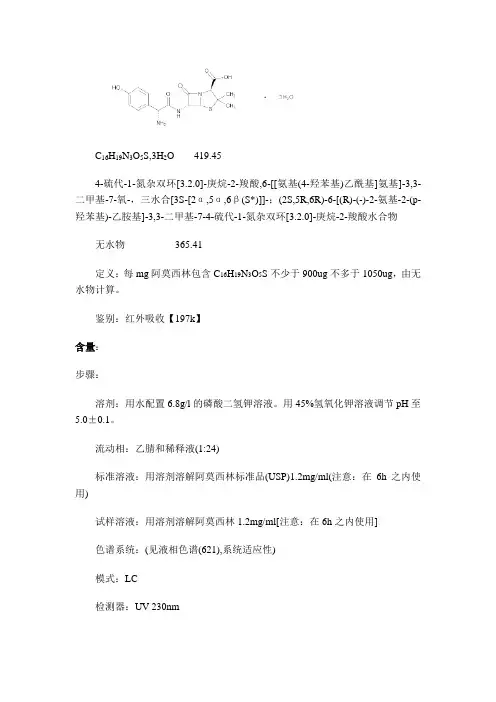
C16H19N3O5S,3H2O 419.454-硫代-1-氮杂双环[3.2.0]-庚烷-2-羧酸,6-[[氨基(4-羟苯基)乙酰基]氨基]-3,3-二甲基-7-氧-,三水合[3S-[2α,5α,6β(S*)]]-;(2S,5R,6R)-6-[(R)-(-)-2-氨基-2-(p-羟苯基)-乙胺基]-3,3-二甲基-7-4-硫代-1-氮杂双环[3.2.0]-庚烷-2-羧酸水合物无水物365.41定义:每mg阿莫西林包含C16H19N3O5S不少于900ug不多于1050ug,由无水物计算。
鉴别:红外吸收【197k】含量:步骤:溶剂:用水配置6.8g/l的磷酸二氢钾溶液。
用45%氢氧化钾溶液调节pH至5.0±0.1。
流动相:乙腈和稀释液(1:24)标准溶液:用溶剂溶解阿莫西林标准品(USP)1.2mg/ml(注意:在6h之内使用)试样溶液:用溶剂溶解阿莫西林1.2mg/ml[注意:在6h之内使用]色谱系统:(见液相色谱(621),系统适应性)模式:LC检测器:UV 230nm柱:4mm×25cm;填充物L1流速:1.5ml/min进样量:10ul系统适应性:样品:标准溶液适应性需求:拖尾因子:不大于2.5相对标准偏差:不大于2.0%分析:试样:标准溶液和样品溶液计算C16H19N3O5S,3H2含量ug/mg用以下公式结果=(ru/rs)×(Cs/Cu)×Pru=样品溶液中得出的峰面积rs=标准品中得出的峰面积Cs=标准品阿莫西林溶液的浓度Cu=样品溶液的浓度P=阿莫西林标准品的效价(ug/mg)验收标准:每mg无水化合物中900~1050ug C16H19N3O5S杂质:有机杂质:步骤:溶液A:2.72g/l磷酸二氢钾。
用1N氢氧化钾或20%磷酸调节pH到5.0±0.1溶液B:含磷的流动相:见下表梯度标准溶液:溶于溶液A中12.5ug/ml阿莫西林标准品系统适用性溶液:溶于溶液A中12.5ug/ml阿莫西林相关物质A和阿莫西林相关物质D样品溶液:用溶液A配置成1.25mg/ml阿莫西林[注意:在4°储存4h之内使用]色谱系统(见色谱,系统适应性)模式:LC检测器:UV 210nm柱:4.6mm×10cm;5um填充物L1柱温:40°流速:1.5ml/min进样量:10ul自动进样器温度:4°系统适应性:样品:标准溶液和系统适应性溶液适应性需求:[注意:在杂质表格1中通过相对保留时间鉴别峰]分辨率:在阿莫西林相关物质A和阿莫西林相关物质D第二峰不少于1.5系统适应性溶液相对标准偏差:不多于标准物质的10%分析:样品:标准溶液和样品溶液计算阿莫西林每一种样品含量的百分率:结果=(ru/rs)×(Cs/Cu) ×F×100ru=从样品溶液中或的的每一个杂质峰rs=从标准溶液中获得的阿莫西林峰Cs=阿莫西林标准品的浓度Cu=阿莫西林样品溶液标示浓度F=单位转换因素(0.001mg/ug)验收标准:[注意:限制是阿莫西林标准溶液吸收峰的0.03%]单杂质:见杂质表1总杂质:不多于5%杂质表1a (R)-2-氨基-2-(4-羟苯基)乙酸b色谱系统区分了两种青霉噻唑酸c(4S)-2-{[(R)-2-氨基-2-(4-羟苯基)乙酰胺基](羧基)甲基}-5,5-二甲基四氢噻唑-4-羧酸d (2S,5R,6R)-6-氨基-3,3-二甲基-7-氧-4-硫代-1-氮杂双环[3.2.0]-庚烷-2-羧酸e列出的化合物仅仅是用作信息不用来报导f(2S,5R,6R)-6-[(S)-2氨基-2-(4-羟苯基)乙酰胺基]-3,3-二甲基-7-氧-4-硫代-1-氮杂双环[3.2.0]-庚烷-2-羧酸g(2S,5R,6R)-6-{(R)-2-[(R)-2-氨基-2-(4-羟苯基)乙酰胺基]-2-(4-羟苯基)乙酰胺基}-3,3-二甲基-7-氧-4-硫代-1-氮杂双环[3.2.0]-庚烷-2-羧酸h色谱系统区分了两种青霉噻唑酸i (4S)-2-{[(R)-2-氨基-2-(4-羟苯基)乙酰胺基]甲基}-5,5-二甲基四氢噻唑-4-羧酸j(2S,5R,6R)-6-(2-[(R)-2-氨基-2-(4-羟苯基)乙酰胺基]-2-((4S)-4-羧基-5,5-二甲基四氢噻唑-2-卤代)乙酰胺基)-3,3-二甲基-7-氧-4-硫代-1-氮杂双环[3.2.0]-庚烷-2-羧酸k 3-(4-羟苯基)对二氮杂苯-2-羟基l (4S)-2-[5-(4-羟苯基)-3,6-二氧哌嗪-2-卤代]-5,5-二甲基四氢噻唑-4-羧酸m(2S,5R,6R)-6-((2R)-2-{2-[(R)-2-氨基-2-(4-羟苯基)乙酰胺基]-2-[(4S)-4羧基-5,5-二甲基四氢噻唑-2-卤代]乙酰胺基}-2-(4-羟苯基)乙酰胺基)-3,3-二甲基-7-氧-4-硫代-1-氮杂双环[3.2.0]-庚烷-2-羧酸n(2S,5R,6R)-6-{(2S,5R,6R)-6-[(R)-2-氨基-2-(4-羟苯基)乙酰胺基]-3,3-二甲基-7-氧-4-硫代-1-氮杂双环[3.2.0] 庚烷-2-羧氨基}-3,3-二甲基-7-氧-4-硫代-1-氮杂双环[3.2.0]-庚烷-2-羧酸。
阿莫西林颗粒被7家企业备案了5种参比制剂,该如何选?
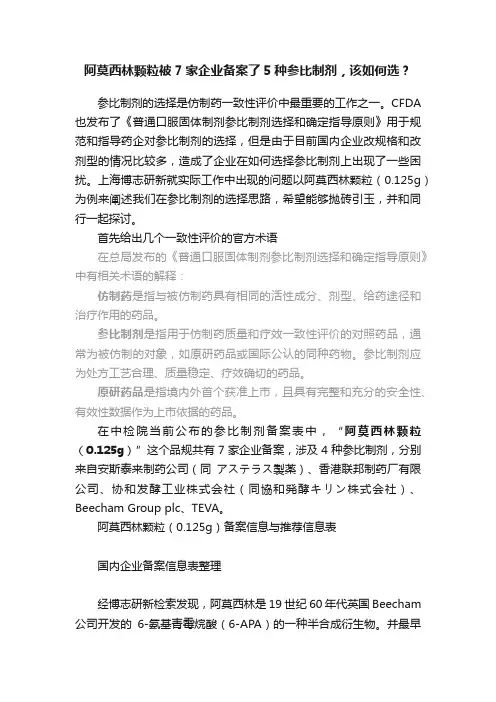
阿莫西林颗粒被7家企业备案了5种参比制剂,该如何选?参比制剂的选择是仿制药一致性评价中最重要的工作之一。
CFDA 也发布了《普通口服固体制剂参比制剂选择和确定指导原则》用于规范和指导药企对参比制剂的选择,但是由于目前国内企业改规格和改剂型的情况比较多,造成了企业在如何选择参比制剂上出现了一些困扰。
上海博志研新就实际工作中出现的问题以阿莫西林颗粒(0.125g)为例来阐述我们在参比制剂的选择思路,希望能够抛砖引玉,并和同行一起探讨。
首先给出几个一致性评价的官方术语在总局发布的《普通口服固体制剂参比制剂选择和确定指导原则》中有相关术语的解释:仿制药是指与被仿制药具有相同的活性成分、剂型、给药途径和治疗作用的药品。
参比制剂是指用于仿制药质量和疗效一致性评价的对照药品,通常为被仿制的对象,如原研药品或国际公认的同种药物。
参比制剂应为处方工艺合理、质量稳定、疗效确切的药品。
原研药品是指境内外首个获准上市,且具有完整和充分的安全性、有效性数据作为上市依据的药品。
在中检院当前公布的参比制剂备案表中,“阿莫西林颗粒(0.125g)”这个品规共有7家企业备案,涉及4种参比制剂,分别来自安斯泰来制药公司(同アステラス製薬)、香港联邦制药厂有限公司、协和发酵工业株式会社(同協和発酵キリン株式会社)、Beecham Group plc、TEVA。
阿莫西林颗粒(0.125g)备案信息与推荐信息表国内企业备案信息表整理经博志研新检索发现,阿莫西林是19世纪60年代英国Beecham 公司开发的6-氨基青霉烷酸(6-APA)的一种半合成衍生物。
并最早于1972年在英国上市,商品名AMOXIL®,持证商为Beecham Group plc。
阿莫西林在美国最早于1974上市,GlaxoSmithKline为持有人,商品名AMOXIL®【参考自FDA说明书】,后来授权给Dr. Reddy’s Laboratories Inc并由其生产,但并未被列为美国参比制剂。
10实验十阿莫西林胶囊的质量检验

三、有关物质检查
色谱条件
m.p D :0.05mol/L磷酸二氢钾溶液(pH5.0)
m.p B :乙腈
Time(min) 0 15 45 55
m.p D 97.5 97.5 80 80
m.p B 2.5 2.5 20 20
56
70
97.5
97.5
2.5
2.5
有关物质检查
样品溶液的配制(2mg/ml)
实验原理
三. RP-HPLC色谱法(略)
实验内容
一. 鉴别
二. 含量测定
三. 有关物质检查
一、鉴别
在含量测定条件下记录的色谱图中,供试品溶液 主峰的保留时间应与对照品溶液主峰的保留时间 一致。
二、含量测定
对照品溶液制备:精密称取阿莫西林对照品约 25mg,置50ml量瓶中,用流动相溶解定容成浓度 为0.468mg/ml溶液。 供试品溶液制备:取本品10片,取胶囊内容物, 精密称定,研细,精密称取适量(约相当于阿莫 西林25mg),置50ml量瓶中,用流动相稀释定容 成每1ml约含0.5mg的溶液,用 0.45μm 滤膜滤过, 取续滤液,精密吸取20μl注入液相色谱仪,记录 色谱图; 按外标一点法以峰面积计算出供试品中 C16H19N3O5S的含量。
实验十
阿莫西林胶囊的质量检验
实验目的
掌握内酰胺类化合物的结构;
熟悉高效液相色谱法的定性、定量方法;
掌握β-内酰胺类抗生素的性质及有关物质检查; 掌握HLPC测定含量的方法。
实验原理
一. 阿莫西林结构 本品主要成分为β-内酰胺类抗生素阿莫西林,本品 含阿莫西林(C16H19N3O5S)应为标示量的 90.0%~110.0%。
色谱条件
阿莫西林内控质量标准
制药GMP管理文件一、目的:制定阿莫西林的内控质量标准,规范公司阿莫西林的采购与使用。
二、适用范围:适用于阿莫西林的采购与验收。
三、责任者:生产部、检验员、仓库保管员。
四、正文:阿莫西林分子式:C16H19N3O5S.3H2O 分子量:419.46本品为(2S,5R,6R)-3,3-二甲基-6-[R-(-)-2-氨基-2-(4-羟基苯基)乙酰氨基]-7-氧代-4-硫杂-1-氮杂双环[3.2.0]庚烷-2-甲酸三水合物。
按无水物计算,含C16H19N3O5S不得少于95.0%。
【性状】本品为白色或类白色结晶性粉末;味微苦。
本品在水中微溶,在乙醇中几乎不溶。
比旋度取本品,精密称定,加水溶解并定量稀释成每1ml中含2mg的溶液,法测定,比旋度为+290°至+315°。
【鉴别】1在含量测定项下记录的色谱图中,供试品主峰的保留时间应与对照品溶液主峰的保留时间一致。
2本品的红外光吸收图谱应与对照的图谱一致。
【检查】酸度取本品,加水制成1ml中含5mg的溶液,在50℃水浴中微温使溶解后,依法测定,PH值应为3.5-5.5。
溶液的澄清度取本品5份,各1.0g,分别加0.5mol/L盐酸溶液10ml 及2mol/L氨溶液10ml溶解后立即观察,溶液均应澄清。
如显浑浊,与2号浊度标准液比较,不得更浓。
水分取本品,照水分测定法测定,含水分应为12.0%~15.0%。
【含量测定】照高效液相色谱法测定。
色谱条件与系统适用性试验用十八烷基硅烷键合硅胶为填充剂;以0.05mol/L磷酸二氢钾溶液(用2mol/L氢氧化钾溶液调节PH值至5.0)—乙腈(96 :4)为流动相;流速为每分钟约1ml;检测波长为254nm。
理论板数按阿莫西林峰计算应不低于2000 。
测定法取本品约25mg,精密称定,置50ml量瓶中,加流动相溶解并定量稀释至刻度,摇匀,精密量取20ul注入液相色谱仪,记录色谱图;另取阿莫西林对照品适量,同法测定。
中国药典和美国药典阿莫西林有关物质检测方法的比较研究
中国药典和美国药典阿莫西林有关物质检测方法的比较研究郑占伟,孟令茹,袁红楼,张晴,李毅**收稿日期:2021-01-13作者简介:郑占伟,工程师,主要从事药物分析工作。
*通讯作者:李毅,高级工程师,主要从事药物分析工作。
(华北制药集团新药研究开发有限责任公司,微生物药物国家工程研究中心,石家庄052160)摘要:目的比较并讨论中国药典和美国药典中阿莫西林有关物质的测定方法,为阿莫西林原料药有关物质检测提供科学依据。
方法采用中国药典2015年版(ChP2015)和美国药典42版(USP42)收载的阿莫西林有关物质方法,分别对系统适用性混合溶液、相对响应因子试验、强制降解试验和样品进行有关物质检测,对色谱行为、已知杂质、有关物质测定结果和杂质控制策 略等进行比较。
结果两国药典方法中色谱条件、系统适用性要求和杂质控制策略存在较大差异,USP 方法对特定杂质的分离效能优于ChP,且样品中检出的杂质数量和总杂含量均高于ChP,较ChP 方法多检出一个己知杂质C,其他已知杂质含量无明显 差异。
结论建议在USP 收载的阿莫西林有关物质方法基础上进一步优化色谱条件,提高方法的分离效能,从而更加有效控制 本品的有关物质。
关键词:中国药典;美国药典;阿莫西林;有关物质中图分类号:R978.F1文献标志码:A 文章编号:1001-8751(2021)03-0189-05Comparative Study on Determination Methods of Amoxicillinin ChinesePharmacopoeia and United States Pharmacopeial ConventionZheng Zhan-Wei, Meng Ling-Ru, Yuan Hong-Lou, Zhang Qing, Li Yi(North China Pharmaceutical Group New Drug R&D Co., Ltd,National Engineering Research Center of M icrobial Medicine, Shijiazhuang 052160)Abstract: Objective To compare and discuss the determination methods of amoxicillin related substances in Chinese Pharmacopoeia (ChP) and United States Pharmacopeial Convention (USP), so as to provide scientific basis for the determination of related substances in amoxicillin. Methods The amoxicillin related substances were determined by adopting the methods of related substances quality standard contained in ChP2015 and USP42. The system suitability, relative response factor, forced degradation and samples were tested. The chromatographic behavior, known impurities, related substances determination results and impurity control strategy were performed the comparison. Results The chromatographic conditions, system applicability requirements and impurity control strategy of two methods have large difference. The USP method was superior to ChP in the separation efficiency of specific impurities, and the quantities and contents of impurity detected in the samples were both higher than that in ChP. Compared with ChP method, one more known impurity C was detected in USP, while there was no significant difference in other known impurities. Conclusion It is suggested to optimize the chromatographic conditions and improve the separation efficiency of amoxicillin based on the USP method, so as to control the related substances of this product more effectively.Keywords: ChP; USP; amoxicillin; related substances阿莫西林(Amoxicillin),又名羟氨节青霉素,是一种半合成的广谱卩■内酰胺类抗生素的青霉素类。
关于阿莫西林胶囊质量标准有关事宜的函
关于阿莫西林胶囊质量标准有关事宜的函【摘要】本文将围绕阿莫西林胶囊的质量标准展开讨论,并重点关注其相关事宜。
我们将从其基本原理、生产过程、标准制定以及质量控制等方面进行深入探究。
通过全面评估和讨论,旨在从简到繁地向读者介绍阿莫西林胶囊的质量标准以及与之相关的重要事项。
【正文】一、阿莫西林胶囊简介阿莫西林胶囊是一种广泛使用的抗菌药物,其有效成分为阿莫西林。
阿莫西林具有广谱抗菌活性,主要用于治疗呼吸道感染、尿路感染、皮肤软组织感染等疾病。
正由于阿莫西林胶囊在医疗领域的广泛应用,其质量标准备受重视。
二、阿莫西林胶囊的质量标准制定与变化1. 药典标准阿莫西林胶囊的质量标准一般参考药典,如中国药典、美国药典和欧洲药典等。
这些药典根据相关法规和标准制定,确保药品的质量和安全性。
2. 相关法规与规范除了药典标准外,阿莫西林胶囊的质量标准还受到相关法规与规范的约束。
在中国,国家食品药品监督管理局(CFDA)颁布的《药品注册管理办法》对药品注册和质量控制提出了具体要求。
3. 质量标准的更新与变化随着科学研究和医疗技术的不断进步,阿莫西林胶囊的质量标准也在不断更新与变化。
这主要是为了更好地适应药品市场的需求以及保证药品的质量和安全性。
质量标准的更新往往需要经过严格的科学评估和专家讨论,确保其合理性和可行性。
三、阿莫西林胶囊的质量控制1. 原辅材料的质量控制阿莫西林胶囊的质量控制首先涉及到其原辅材料的选择和质量控制。
这包括阿莫西林的纯度、辅料的纯度以及药品中杂质的限制等方面。
合格的原辅材料是保证阿莫西林胶囊质量的基础。
2. 生产过程的质量控制阿莫西林胶囊的生产过程需要严格控制,以确保其质量的稳定性和一致性。
生产过程中的关键环节包括原料的配制、混合、制粒、包衣、包装等。
生产过程的每个环节都需要符合标准操作程序,并进行必要的监控和验证,以确保药品的质量。
3. 成品的质量控制阿莫西林胶囊的成品质量控制是为了验证阿莫西林胶囊最终的质量是否符合预期的要求。
阿莫西林胶囊一致性评价方案
1.1. 通用名:阿莫西林1.2. 英文名:Amoxicillin1.3. 化学名称:(2S,5R,6R)-3,3-二甲基-6-[(R)-(-)-2-氨基-2-(4-羟基苯基)乙酰氨基]-7-氧代-4-硫杂-1-氮杂双环[3.2.0]庚烷-2-甲酸三水合物1.4. 结构式:1.5. 分子式::C16H19N3O5S・3H2O1.6. 分子量:419.451.7. CAS登记号:26787-78-01.8. 剂型和规格:胶囊剂,0.25g。
2. 品种简介阿莫西林为半合成广谱青霉素类药,抗菌谱及抗菌活性与氨苄西林基本相同,但其耐酸性较氨苄西林强,其杀菌作用较后者强而迅速,但不能用于脑膜炎的治疗。
半衰期约为61.3分钟。
阿莫西林在酸性条件下稳定,胃肠道吸收率达90%,较氨苄西林吸收更迅速完全,除对志贺菌效果较氨苄西林差以外,其余效果相似。
阿莫西林杀菌作用强,穿透细胞膜的能力也强。
是目前应用较为广泛的口服半合成青霉素之一,其制剂有胶囊、片剂、颗粒剂、分散片等等,现在常与克拉维酸合用制成分散片。
阿莫西林于1972年在英国上市,由Beecham制药厂(隶属于GSK)开发;美国在1974年上市,申请人GLAXOSMITHKLINE;日本最早在1975年上市。
3. 适应症、推荐剂量和治疗窗阿莫西林适用于敏感菌(不产β内酰胺酶菌株)所致的下列感染:1.溶血链球菌、肺炎链球菌、葡萄球菌或流感嗜血杆菌所致中耳炎、鼻窦炎、咽炎、扁桃体炎等上呼吸道感染。
2.大肠埃希菌、奇异变形杆菌或粪肠球菌所致。
口服。
1.成人一次0.5g,每6~8小时1次,一日剂量不超过4g。
2.小儿一日剂量按体重20~40mg/kg,每8小时1次;3.3个月以下婴儿一日剂量按体重30mg/kg,每12小时1次。
4.肾功能严重损害患者需调整给药剂量,其中内生肌酐清除率为10~30ml/分钟的患者每12小时0.25~0.5g;内生肌酐清除率小于10ml/分钟的患者每24小时0.25~0.5g。
- 1、下载文档前请自行甄别文档内容的完整性,平台不提供额外的编辑、内容补充、找答案等附加服务。
- 2、"仅部分预览"的文档,不可在线预览部分如存在完整性等问题,可反馈申请退款(可完整预览的文档不适用该条件!)。
- 3、如文档侵犯您的权益,请联系客服反馈,我们会尽快为您处理(人工客服工作时间:9:00-18:30)。
C16H19N3O5S,3H2O 419.45
4-硫代-1-氮杂双环[3.2.0]-庚烷-2-羧酸,6-[[氨基(4-羟苯基)乙酰基]氨基]-3,3-二甲基-7-氧-,三水合[3S-[2α,5α,6β(S*)]]-;(2S,5R,6R)-6-[(R)-(-)-2-氨基-2-(p-羟苯基)-乙胺基]-3,3-二甲基-7-4-硫代-1-氮杂双环[3.2.0]-庚烷-2-羧酸水合物
无水物365.41
定义:每mg阿莫西林包含C16H19N3O5S不少于900ug不多于1050ug,由无水物计算。
鉴别:红外吸收【197k】
含量:
步骤:
溶剂:用水配置6.8g/l的磷酸二氢钾溶液。
用45%氢氧化钾溶液调节pH至5.0±0.1。
流动相:乙腈和稀释液(1:24)
标准溶液:用溶剂溶解阿莫西林标准品(USP)1.2mg/ml(注意:在6h之内使用)
试样溶液:用溶剂溶解阿莫西林1.2mg/ml[注意:在6h之内使用]
色谱系统:(见液相色谱(621),系统适应性)
模式:LC
检测器:UV 230nm
柱:4mm×25cm;填充物L1
流速:1.5ml/min
进样量:10ul
系统适应性:
样品:标准溶液
适应性需求:
拖尾因子:不大于2.5
相对标准偏差:不大于2.0%
分析:
试样:标准溶液和样品溶液计算C16H19N3O5S,3H2含量ug/mg用以下公式结果=(ru/rs)×(Cs/Cu)×P
ru=样品溶液中得出的峰面积
rs=标准品中得出的峰面积
Cs=标准品阿莫西林溶液的浓度
Cu=样品溶液的浓度
P=阿莫西林标准品的效价(ug/mg)
验收标准:每mg无水化合物中900~1050ug C16H19N3O5S
杂质:
有机杂质:
步骤:溶液A:2.72g/l磷酸二氢钾。
用1N氢氧化钾或20%磷酸调节pH到5.0±0.1
溶液B:含磷的
流动相:见下表梯度
标准溶液:溶于溶液A中12.5ug/ml阿莫西林标准品
系统适用性溶液:溶于溶液A中12.5ug/ml阿莫西林相关物质A和阿莫西林相关物质D
样品溶液:用溶液A配置成1.25mg/ml阿莫西林[注意:在4°储存4h之内使用]
色谱系统
(见色谱,系统适应性)
模式:LC
检测器:UV 210nm
柱:4.6mm×10cm;5um填充物L1
柱温:40°
流速:1.5ml/min
进样量:10ul
自动进样器温度:4°
系统适应性:
样品:标准溶液和系统适应性溶液
适应性需求:
[注意:在杂质表格1中通过相对保留时间鉴别峰]
分辨率:在阿莫西林相关物质A和阿莫西林相关物质D第二峰不少于1.5系统适应性溶液
相对标准偏差:不多于标准物质的10%
分析:
样品:标准溶液和样品溶液计算阿莫西林每一种样品含量的百分率:
结果=(ru/rs)×(Cs/Cu) ×F×100
ru=从样品溶液中或的的每一个杂质峰
rs=从标准溶液中获得的阿莫西林峰
Cs=阿莫西林标准品的浓度
Cu=阿莫西林样品溶液标示浓度
F=单位转换因素(0.001mg/ug)
验收标准:[注意:限制是阿莫西林标准溶液吸收峰的0.03%]
单杂质:见杂质表1
总杂质:不多于5%
杂质表1
a (R)-2-氨基-2-(4-羟苯基)乙酸
b色谱系统区分了两种青霉噻唑酸
c(4S)-2-{[(R)-2-氨基-2-(4-羟苯基)乙酰胺基](羧基)甲基}-5,5-二甲基四氢噻唑-4-羧酸
d (2S,5R,6R)-6-氨基-3,3-二甲基-7-氧-4-硫代-1-氮杂双环[3.2.0]-庚烷-2-羧酸
e列出的化合物仅仅是用作信息不用来报导
f(2S,5R,6R)-6-[(S)-2氨基-2-(4-羟苯基)乙酰胺基]-3,3-二甲基-7-氧-4-硫代-1-氮杂双环[3.2.0]-庚烷-2-羧酸
g(2S,5R,6R)-6-{(R)-2-[(R)-2-氨基-2-(4-羟苯基)乙酰胺基]-2-(4-羟苯基)乙酰胺基}-3,3-二甲基-7-氧-4-硫代-1-氮杂双环[3.2.0]-庚烷-2-羧酸
h色谱系统区分了两种青霉噻唑酸
i (4S)-2-{[(R)-2-氨基-2-(4-羟苯基)乙酰胺基]甲基}-5,5-二甲基四氢噻唑-4-羧酸
j(2S,5R,6R)-6-(2-[(R)-2-氨基-2-(4-羟苯基)乙酰胺基]-2-((4S)-4-羧基-5,5-二甲基四氢噻唑-2-卤代)乙酰胺基)-3,3-二甲基-7-氧-4-硫代-1-氮杂双环[3.2.0]-庚烷-2-羧酸k 3-(4-羟苯基)对二氮杂苯-2-羟基
l (4S)-2-[5-(4-羟苯基)-3,6-二氧哌嗪-2-卤代]-5,5-二甲基四氢噻唑-4-羧酸
m(2S,5R,6R)-6-((2R)-2-{2-[(R)-2-氨基-2-(4-羟苯基)乙酰胺基]-2-[(4S)-4羧基-5,5-二甲基四氢噻唑-2-卤代]乙酰胺基}-2-(4-羟苯基)乙酰胺基)-3,3-二甲基-7-氧-4-硫代-1-氮杂双环[3.2.0]-庚烷-2-羧酸
n(2S,5R,6R)-6-{(2S,5R,6R)-6-[(R)-2-氨基-2-(4-羟苯基)乙酰胺基]-3,3-二甲基-7-氧-4-硫代-1-氮杂双环[3.2.0] 庚烷-2-羧氨基}-3,3-二甲基-7-氧-4-硫代-1-氮杂双环[3.2.0]-庚烷-2-羧酸。
